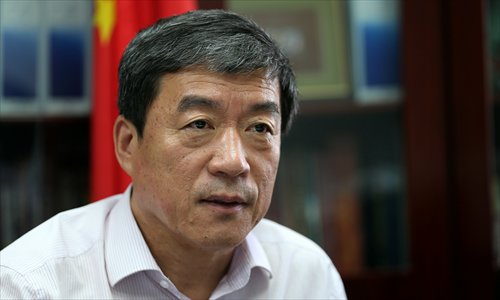Boom to place Xinjiang as Central Asia’s economic hub

He Yiming, director and Party chief of the Department of Commerce of Xinjiang Uyghur Autonomous Region, is interviewed in Xinjiang on Wednesday. Photo: Cui Meng/GT
Editor's note:
As Northwest China's Xinjiang Uyghur Autonomous Region establishes itself as a center for China's Silk Road Economic Belt, the region's government plans to let trade lead its economic and social development. Global Times (GT) reporter Bai Tiantian speaks with He Yiming, director and Party chief of the Department of Commerce of Xinjiang Uyghur Autonomous Region.
GT: Can you give us an introduction of Xinjiang's trade this year?
He: From January to May, the total trade volume in Xinjiang was $6.13 billion, up 6.8 percent from last year. Xinjiang was ranked 22nd among all provincial-level regions in China in terms of trade volume from January to May, but our growth was second in the nation.
Border trade constitutes the most important part, accounting for 56.8 percent of the total trade in Xinjiang and 27.5 percent of small trade imports and exports in China. Our trade also relies very heavily on the private sector, which constitutes 85.3 percent of our total volume. Textiles, electronics and mechanical products saw double-digit growth this year.
However, we still face some difficulties. For starters, the sluggish global economy, falling international commodity prices and downward pressure in the domestic economy are all factors of concern this year. Currency devaluation in Russia and Central Asian countries, which leads to a decline in purchasing power, also casts a shadow on our trade prospects.
The Eurasian Economic Union, which aims to remove internal tariff barriers while imposing a common external tariff, has had a profound influence on Xinjiang's trade. After joining the Eurasian Economic Union, the average tariff for Kazakhstan, Kyrgyzstan and Armenia actually increased, leading to a decline in exports to some Central Asian nations.
Xinjiang wishes to achieve an annual trade volume of $20.8 billion this year. We have geographical advantages, backed by a strong industrial system in China. We would like to let trade lead the way so that when trade volume reaches a certain level, industries will naturally relocate to Xinjiang.
Another thing we are working on is diversifying our trade structure. Currently our trade focuses on textiles, electronics and mechanical products, bags and luggage and agricultural products. We are looking to open up new markets, for example Southeast Asia. Fruits grown in Xinjiang are not found in Southeast Asia and vice versa. The regions complement each other.
GT: Which countries are Xinjiang's largest trade partners and how does Xinjiang cooperate with these countries?
He: The largest trade partners of Xinjiang are Kazakhstan, Kyrgyzstan, Russia and Tajikistan, in that order. Trade with these four countries constitutes more than 75 percent of Xinjiang's total trade with foreign countries. Kazakhstan alone took up about 40 percent last year. It used to take up more. Russia has recently caught up and become third.
As for trade structure, these countries displayed similar characteristics. Textiles and electronics are the top two exports. These countries are interested in importing light industrial products from China.
GT: We understand that Xinjiang is establishing itself as a core area for the Silk Road Economic Belt. One of Xinjiang's goals is to make itself a commercial and logistics center. Can you talk about how Xinjiang, and especially your department, wish to achieve that goal?
He: A key focus of our work is building a land port in Urumqi. The project consists of online and offline parts. For the offline part, the idea is to make use of the highway, railroad and aviation networks, as well as free trade zones, container terminal stations and other resources in Urumqi, to offer freight consolidation services with the supervision of customs. The online part involves building a multi-language platform connecting different logistics nodes both along the Silk Road route and with other provinces in China. We want to build a platform where logistics supply and demand information can flow freely, and information of freight shipping with highways, railroads and aviation can be combined and connected.
Our goal is to build a highly-efficient two-way logistic channel connecting Europe and Asia. Take our freight rail route to Central Asia and Europe as an example. There has been a problem where the return trip doesn't bring back enough merchandise. The land port project in Urumqi is designed to solve this issue. Domestic goods, when shipped to Urumqi, will be regrouped and consolidated in a more efficient way before shipping out. Our goal is to cut 25 percent of the cost of a one-way trip to attract more customers. The same idea also applies to international goods coming into China.
GT: Part of your job is to oversee the management work of the Sino-Kazakh Cooperation Center in Khorgas along the China-Kazakhstan border. Can you tell us more about this center?
He: The center was designed to enjoy a high degree of freedom in terms of trade and commerce. Chinese visitors are allowed to buy up to 8,000-yuan worth of duty-free products. The center can be used for other functions such as storage, exhibitions and finance. Trade fairs will be held here. It is designed to serve as a window where business people from both sides can be exposed to new opportunities.
A good example is the Chung Ying Street, a street on the border of Hong Kong and Shenzhen. In the past, people used to go there and buy products such as socks, radios and CD players. As business boomed, industry followed suit. Today Shenzhen has become a high-tech and manufacturing hub in southern China, and border trade on Chung Ying Street helped cultivate that. This is an example we look up to.
Newspaper headline: Trade in sight